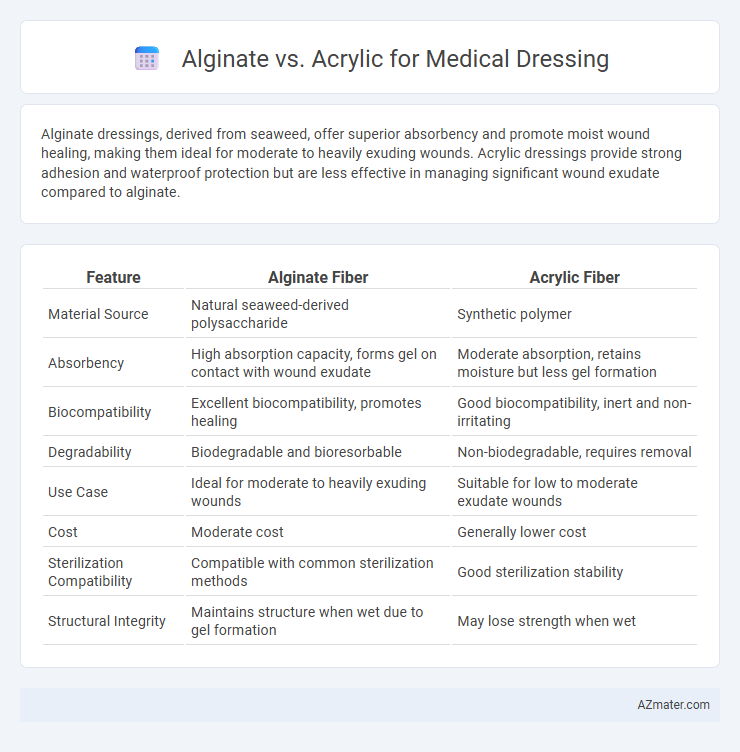Alginate dressings, derived from seaweed, offer superior absorbency and promote moist wound healing, making them ideal for moderate to heavily exuding wounds. Acrylic dressings provide strong adhesion and waterproof protection but are less effective in managing significant wound exudate compared to alginate.
Table of Comparison
| Feature | Alginate Fiber | Acrylic Fiber |
|---|---|---|
| Material Source | Natural seaweed-derived polysaccharide | Synthetic polymer |
| Absorbency | High absorption capacity, forms gel on contact with wound exudate | Moderate absorption, retains moisture but less gel formation |
| Biocompatibility | Excellent biocompatibility, promotes healing | Good biocompatibility, inert and non-irritating |
| Degradability | Biodegradable and bioresorbable | Non-biodegradable, requires removal |
| Use Case | Ideal for moderate to heavily exuding wounds | Suitable for low to moderate exudate wounds |
| Cost | Moderate cost | Generally lower cost |
| Sterilization Compatibility | Compatible with common sterilization methods | Good sterilization stability |
| Structural Integrity | Maintains structure when wet due to gel formation | May lose strength when wet |
Introduction to Medical Dressing Materials
Alginate and acrylic are common materials used in medical dressings, each offering distinct properties suited for wound care. Alginate dressings, derived from seaweed, excel in absorbing exudate and promoting hemostasis, making them ideal for moderately to heavily exuding wounds. Acrylic dressings, composed primarily of synthetic polymers, provide a breathable, flexible barrier that supports a moist wound environment while offering durability and adhesive strength.
Overview of Alginate Dressings
Alginate dressings are derived from seaweed and consist of calcium alginate fibers known for their high absorbency and ability to form a gel upon contact with wound exudate, promoting a moist healing environment. These dressings are particularly effective for moderate to heavily exuding wounds, including ulcers, burns, and surgical sites, due to their superior fluid retention and hemostatic properties. Alginate dressings facilitate autolytic debridement and can reduce bacterial contamination, making them a preferred choice in wound care management compared to acrylic dressings, which are typically used for lighter exudate and skin protection.
Overview of Acrylic Dressings
Acrylic dressings for medical use are known for their superior transparency, allowing easy wound inspection without removal and minimizing infection risk. These dressings offer excellent moisture vapor permeability, maintaining an optimal moist environment conducive to faster healing and reduced maceration. Their hypoallergenic and non-adherent properties ensure patient comfort and minimize trauma during dressing changes.
Composition and Mechanism of Action
Alginate dressings are composed of natural polysaccharides derived from seaweed, primarily calcium alginate, which interact with wound exudate to form a hydrophilic gel that maintains a moist healing environment and promotes hemostasis through calcium ion exchange. Acrylic dressings, made from synthetic polymers like polyacrylates, create a semi-permeable barrier that absorbs exudate via hydrogel formation while protecting against bacterial contamination and ensuring moisture vapor transmission. The calcium ions in alginate dressings actively stimulate clotting, whereas acrylic dressings rely primarily on their absorptive and protective polymer matrix to facilitate wound healing.
Absorption Capabilities: Alginate vs Acrylic
Alginate dressings exhibit superior absorption capabilities due to their natural ability to form a gel upon contact with wound exudate, effectively managing moderate to heavy drainage and maintaining a moist wound environment. Acrylic dressings, while providing a breathable, semi-permeable barrier, generally offer lower absorption capacity and are more suited for low to moderate exudate wounds. The choice between alginate and acrylic depends heavily on the wound's exudate level, with alginate preferred for high-absorption needs and acrylic for protective, less absorbent applications.
Suitability for Different Wound Types
Alginate dressings are highly suitable for moderate to heavily exuding wounds, including chronic ulcers, surgical wounds, and burns, due to their superior absorption and gel-forming properties that maintain a moist wound environment. Acrylic dressings, featuring a semi-permeable, transparent film, are ideal for superficial wounds with minimal exudate, such as abrasions and minor cuts, providing protection while allowing oxygen permeability and easy monitoring. The choice between alginate and acrylic depends on the wound's exudate level, depth, and healing stage, with alginates excelling in moisture management and acrylics offering a breathable protective barrier.
Infection Control and Antimicrobial Properties
Alginate dressings derived from seaweed offer superior moisture retention and excellent fluid absorption, promoting a moist wound environment that reduces bacterial growth and supports infection control. Acrylic dressings provide effective barrier protection with antimicrobial properties through integrated agents that inhibit microbial proliferation, making them suitable for managing infected or high-risk wounds. Comparing infection control efficacy, alginate's natural bioactive compounds and acrylic's synthetic antimicrobial technology deliver targeted approaches to minimize wound infection and accelerate healing.
Patient Comfort and Ease of Application
Alginate dressings offer superior patient comfort due to their high absorbency and gel formation, which maintains a moist wound environment and minimizes pain during dressing changes. Acrylic dressings provide ease of application with their flexible, transparent material allowing for secure adhesion and easy monitoring of the wound without removal. Both materials balance comfort and convenience, but alginate is preferred for highly exudative wounds, while acrylic is favored for low to moderate exudate and delicate skin.
Cost-Effectiveness and Availability
Alginate dressings, derived from seaweed, offer high absorbency and natural hemostatic properties, making them cost-effective for highly exudative wounds but are generally more expensive than acrylic options. Acrylic dressings, often synthetic and designed for light to moderate wound exudate, provide a lower-cost alternative with wider availability in general healthcare settings. The choice between alginate and acrylic medical dressings depends heavily on wound severity, budget constraints, and regional supply chains impacting overall cost-effectiveness and accessibility.
Choosing the Right Dressing: Key Considerations
Alginate dressings, derived from seaweed, excel in managing moderate to heavy exudate by forming a moist gel that promotes wound healing and minimizes infection risk. Acrylic dressings, composed of synthetic polymers, provide a breathable, waterproof barrier ideal for protecting wounds in low to moderate exudate conditions while maintaining moisture balance. Selecting the right dressing depends on exudate levels, wound type, infection risk, and patient comfort to optimize healing outcomes effectively.

Infographic: Alginate vs Acrylic for Medical dressing
 azmater.com
azmater.com